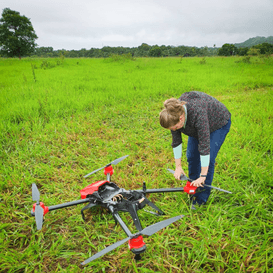- Home
-
Products
- News
- About
- Become a Distributor
Global - English

In a densely planted orchard of Brazil, an XAG agricultural drone was flying and spraying on top of the citrus trees. Regina Hakvoort was the team lead of this operation and sending drone to control pest was her most familiar routine. This time, her mission was to cut down the cost by halving chemical use and stop the pest from recurring.

While drone was spraying fruit trees, Regina marked down drone operation status on her notebook
As the breadbasket of the world, Brazil is the major global supplier of soybeans, corn, cotton, and sugar. Over 28% of its land area was used for agriculture, accounting for 9% of the total domestic employment. However, the increasing costs of crop protection pose a challenge to farmers who struggle to reap profits from their land.
While producers are looking for solutions to save on chemical sprays, Hakvoort spearheads precision farming efforts in Brazil. She has used the XAG P series drones to effectively control agricultural pests and help relieve the financial burden of farmers.
Farmers Bear Most of the Burden
Brought up in a farmer’s family, Regina Hakvoort set up an agricultural service company Anáhata, which includes XAG’s agricultural drone as the innovative solution on crop protection.
After graduated from the University of São Paulo, she started her career as an agronomist and helped run her family farm. According to Regina, whether pests can be successfully managed is highly associated with the financial position of farm owners. When expanding the plantation scale to reap more harvest, they must pay a high price for spraying pesticides and hiring manual labor.

Regina was setting an XAG agricultural drone before it was carried to an operation
Since the national ban on toxic pesticides, Brazilian farmers turn to use eco-friendly pesticides to spray crops, but the outcome falls short of expectation. "Many farmers remain the tradition of blanket spray by tractors, and they have increased the use of pesticides to ensure that pests could be eliminated. For example, the corn fields were sprayed 18 times while that frequency can surprisingly reach 30 times for cotton," Regina said.
Moreover, no matter how much has been invested, a heavy rain during the harvest season could easily ruin the crops, turning the families' whole-year effort in vain. Farmers are exposed to the high risk of investing more but earning less.
During college, Regina had learned about the "low volume spraying" and "ultra-low volume spraying" technology, which allows chemicals to be sprayed in high concentration and achieve better application rate. It means that chemical dosage can be significantly reduced. To her surprise, this technology has already been around for over 50 years, yet few farmers knew about it.
"If I just lecture and taught people about low volume spraying, it was like having only one leg but trying to run. Therefore, I practice this approach with XAG’s drone to address overdose and help more farmers get rid of the cost burden," said Regina.
Drone to Reduce Chemicals and Save Costs

Regina and staff from Megadrone Brasil, XAG’s local partner in Brazil
In the past, low-volume spraying was achieved primarily through large, expensive fixed-wing plant protection aircraft. The introduction of XAG’s agricultural drone has offered a more reasonable price, and its operation is fully automated. This persuaded Regina to invest in drones and collaborate with XAG's local partner Megadrone Brasil.
Drone offered Regina diverse options when she combated cotton weevils, a destructive pest that has wreaked havoc on crops in Brazil. Farmers used to apply more than 30-liter pesticide for every hectare but still had difficulty controlling the spread of cotton boll weevils.
With drone spraying, the cotton weevil can now be controlled with only one liter for the same size of land, significantly reducing farmers' cost and resulting in high yield. Due to its precision spraying technology, the XAG drone can navigate and adjust the fine droplet size to precisely cover each plant.
Regina has also helped a vineyard farm treat fungal disease with 40% less chemical. The XAG agricultural drone was used to target on the infected spots and spray at centimeter-level accuracy.

Regina and her team prepared crop service in an orchard of Brazil
She said, "in the old-fashioned way, farmers of this vineyard sprayed with tractor five times a week, but the mildew just kept recurring. After scouting the fields, I found out that the disease only occurred on young grape leaves, which happened to be the areas that were missed during boom spray."
Seeing the Farmland From "Her" Vision
Starting business as a woman in the agriculture sector, Regina feels challenges everywhere. In her view, a great part of her work is educating the market, as well as finding the right partners to progress together and achieve mutual benefits. "I expect cooperation with trailblazers who respect the value of knowledge and women in agriculture," she said.
As drone technology is landing on farms in Brazil, there have been more and more women riding the wave to engage in agriculture and showcase their entrepreneurship. People of all genders and ages from rural areas will have equal opportunities to develop their talents and work together to safeguard the agricultural powerhouse.
Photo credit: Megadrone Brasil, Anáhata, Timber